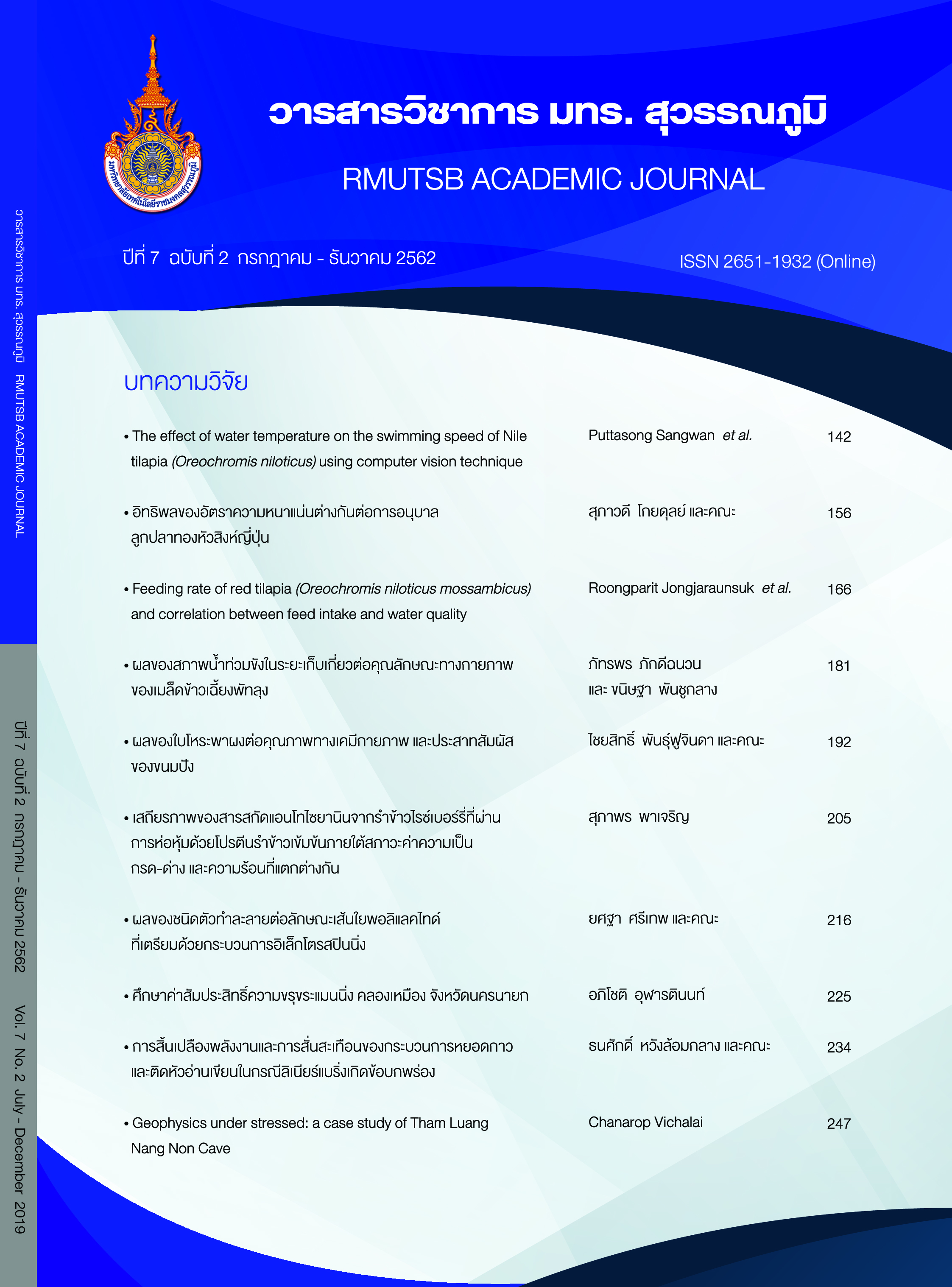Feeding rate of red tilapia (Oreochromis niloticus mossambicus) and correlation between feed intake and water quality
Main Article Content
Abstract
This study investigated the feeding rate and correlation between feed intake (FI) and water quality parameters of red tilapia cage culture suspended in earthen ponds. The first experiment conducted in laboratory condition to investigate the feeding rate and the results show that the feeding rates in the laboratory of fish sizes 100, 200, 300, 400, 500, 600, 700 and 800 g were 3.61±0.22, 3.22±0.43, 2.72±0.35, 2.59±0.22, 2.27±0.11, 2.24±0.05, 2.15±0.04 and 2.07±0.04% of their body weight, respectively. The second experiment was performed in outdoor cages suspended in earthen ponds conditions. There was a negative relationship between total ammonia nitrogen (TAN) level in the pond water on FI and average daily gain (ADG). Whenever TAN level was higher than 0.5 mg L-1, FI and ADG would decrease.
Article Details
Published manuscript are the rights of their original owners and RMUTSB Academic Journal. The manuscript content belongs to the authors' idea, it is not the opinion of the journal's committee and not the responsibility of Rajamangala University of Technology Suvarnabhumi
References
Atwood, H. L., Fontenot, Q. C., Tomasso, J. R., & Isely, J. J. (2001). Toxicity of nitrite to Nile tilapia effect of fish size and environmental chloride. North American Journal of Aquaculture, 63, 49-51.
Avnimelech, Y., & Ritvo, G. (2003). Shrimp and fish pond soils: processes and management. Aquaculture, 220, 549-567.
Azaza, M. S., Dhraїef, M. N., & Kraїem, M. M. (2008). Effect of water temperature on growth and sex ratio of juvenile Nile tilapia Oreochromis niloticus (Linnaeus) reared in geothermal waters in southern Tunisia. Journal of Thermal Biology, 33, 98-105.
Benfield, M. C., & Minello. T. J. (1996). Relative effects of turbidity and light intensity on reactive distance and feeding of an estuarine fish. Environmental Biology of Fishes, 46, 211-216.
Caldini, N. N., RebouÇas, V. T., Cavalcante, D. D. H., Martins, R. B., & Marcelo, V. D. (2011). Water quality and Nile tilapia growth performance under different feeding schedules. Maringá, 33, 427-430.
Cheng, W., Hsiao, I. S., & Chen, J. C. (2004). Effect of ammonia on the immune response of Taiwan abalone Haliotis diversicolor supertexta and its susceptibility to Vibrio parahaemolyticus. Fish Shellfish Immunol, 17, 193-202.
EI-Sayed, A.-F. M. (2002). Effects of stocking density and feeding levels on growth and feed efficiency of Nile tilapia (Oreochromis niloticus L.) fry. Aquaculture Research, 22, 621-626.
EI-Sayed, A.-F. M. (2006). Tilapia culture. Wallingford: CABI Publishing.
El-Sherif, M. S., & El-Feky, A. M. I. (2009). Performance of Nile tilapia (Oreochromis niloticus) fingerlings. I. Effect of pH. International Journal of Agriculture and Biology, 11, 297-300.
Gregory, R. S., & Northcote, T. G. (1993). Surface planktonic and benthic foraging by juvenile Chinook salmon (Oncorhynchus tshawytscha) in turbid laboratory conditions. Canadian Journal of Fisheries and Aquatic Sciences, 50, 233-240.
Hargreaves, J. A., & Tucker, C. S. (2004). Managing ammonia in fish ponds. Stoneville: Southern Regional Aquaculture Center.
Hecht, T., & van der Lingen, C. D. (1992). Turbidity induced changes in feeding strategies offish in estuaries. South African Journal of Zoology, 27, 95-107.
Jobling, M. (1994). Fish bioenergetics. London: Chapman and Hall.
Kolding, J., Haug, L., & Stefansson, S. (2008). Effect of ambient oxygen on growth and reproduction in Nile tilapia (Oreochromis niloticus). Canadian Journal of Fisheries and Aquatic Sciences, 65, 1413-1424.
Kunlasak, K., Chitmanat, C., Whangchai, N., Promya, J., & Lebel, L. (2013). Relationship of dissolved oxygen with chlorophyII-a and phytoplankton composition in Tilapia ponds. International Journal of Geosciences, 4, 46-53.
Lawson, T. B. (1994). Fundamentals of Aquacultural Engineering. New York: Chapman and Hall.
Little, D. C., & Edwards, P. (2004). Impact of nutrition and season on pond culture performance of mono-sex and mixed-sex Nile tilapia (Oreochromis niloticus). Aquaculture, 232, 279-292.
Lovell, T. (1989). Nutrition and feeding of fish. New York: Van Nostrand Reinhold.
Martins, C. I. M., Conceiçã, L. E. C., & Schrama, J. W. (2011). Consistency of individual variation in feeding behavior and its relationship with performance traits in Nile tilapia Oreochromis niloticus. Applied animal behaviour science, 133, 109-116.
Masautso, E. S., & Musuka, C. G. (2014). The effect of ammonia on growth and survival rate of Tilapia rendalli in quail manured tanks. International Journal of Aquaculture, 4, 1-6.
Nayara, N. C., Vanessa, T. R., Davi, D. H. C., Rafael, B. M., & Arcelo, V. D. C. S. (2011). Water quality and Nile tilapia growth performance under different feeding schedules. Maringá, 33, 427-430.
Pinto, C., Aragão, C., Soares, F., Dinis, M. T., & Conceição, L. E. C. (2007). Growth, stress response and free amino acid levels in Senegalese sole (Solea senegalensis Kaup 1858) chronically exposed to exogenous ammonia. Aquaculture Research, 38, 1198-1204.
Riche, M., & Garling, D. (2003). Feeding tilapia in intensive recirculating systems. North Central Regional Aquaculture Center In cooperation with USDA Fact Sheet Series #114. Ames, USA: Iowa State University.
Riche, M. (2004). Effect of feeding frequency on consumption, growth, and efficiency in juvenile tilapia (Oreochromis niloticus). The Israeli Journal of Aquaculture, 56(4), 247-255.
Santiago, C. B., Aldaba, M. B., & Reyes, O. S. (1987). Influence of feeding rate and diet form on growth and survival of Nile tilapia (Oreochromis niloticus) fry. Aquaculture, 64, 277-282.
Soderberg, R. W. (1994). Flowing water fish culture. Boca Raton: CRC Press.
Steffens, W. (1989) Principle of fish nutrition. West Sussex: Ellis Horwood.
Szyper, P. J., & Lin, C. K. (1990). Techniques for assessment of stratification and effects of mechanical mixing in tropical fish ponds. Aquacultural Engineering, 9, 151-165.
Tran-Duy, A., Van dam, A. A., & Schrama, J. W. (2012). Feed intake, growth and metabolism of Nile tilapia (Oreochromis niloticus) in relation to dissolved oxygen concentration. Aquaculture Research, 43, 730-744.
Wang, T., Lefevre, S., Huong, D. T. T., Cong, N. V., & Bayley, M. (2009). Effects of hypoxia on growth and digestion. Fish physiology, 27, 364-396.


